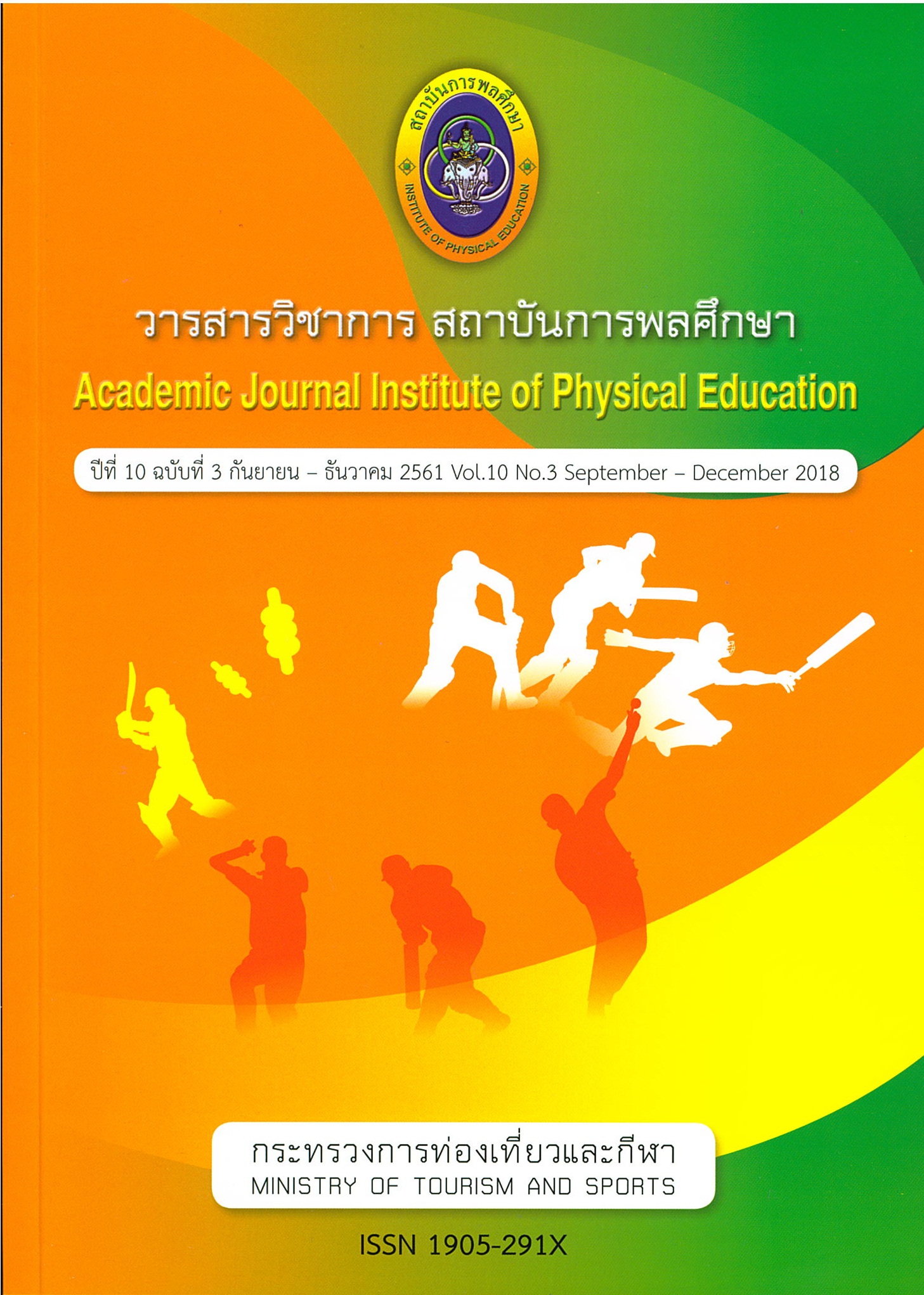Effects of The Progressive Relaxation Training on the Stress and Archery Skill of Archer Institute of Physical Education
Main Article Content
Abstract
Theobjectiveof this R&D researchis aimed (1) To develop the progressive relaxation (PR) program, and (2) To compare pre-and post-experiment stress levels and archery skills between experimental group and control group. Methodologically, Firstly, develop the PR program by analysis and synthesisof documents and determinethe qualityof the program with the use of the checklist,and secondly, determine the effectiveness of the program by the trial use. The samples include archer’s Institution of Physical Education. In this study, the subjects are divided into two groups; experimental group and the control group; each group of 35 participants.The experiment lasts 6 weeks, 6 days a week.The pre and post experimental stress and archery skills were assessed. The statistics implemented in data analysis included mean, standard deviation, paired t-test, and independent t-test. The results showed that (1) ThePR program consists of three elements: factor elements, process elements, and mechanical elements. It found that the quality of PR program was satisfactory, and (2) The comparison of mean scores on stress level between experimental group and the control group post-experimentally showed astatistically significant difference at .01 level ( =1.63,S.D. = 0.11; =1.92,S.D. = 0.16, respectively; t = 8.33, p-value = 0.00).The
comparison of mean scores on archery skills between experimental group and the control group post-experimentallyshowed astatisticallysignificant differenceat .01level ( = 258.74, S.D. = 13.02;
= 248.17, S.D. = 22.30, respectively; t = 2.42, p-value = 0.00).
Insummary, (1)The PR program consisted of three elements: factor elements, process elements, and mechanical elements (2) Development of archery by using the PR program, together with archery practice may lower the stress levels in the archer and archery skills could be improved better than practicing archery alone.
Article Details
The published article is a copyright of the Academic Journal of Thailand National Sports University. The passage appeared in each article in this academic journal is a perspective of each author which is not related to the journal. Each author is required to be responsible for all components of his/her own article. If there are any mistakes, each author must be responsible for those mistakes on his/her own.
References
จตุรงค์ เหมรา และอนุรักษ์ ปัญญานุวัฒน์. (2559). รูปแบบการพัฒนาสมรรถนะการทำวิจัยของคณาจารย์สถาบันการพลศึกษาภาคเหนือ. วารสารวิชาการสถาบันการพลศึกษา. ปีที่ 8 ฉบับที่ 1: 31-47.
จตุรงค์ เหมรา, โกศล รอดมา,ศรีประไพ อินทร์ชัยเทพ,อุมาภรณ์ คงอุไร และยุทธพงษ์ เรืองจันทร์. (2560). การพัฒนาตัวบ่งชี้ความสำเร็จยุทธศาสตร์ของศูนย์กีฬาเพื่อความเป็นเลิศในสถาบันการพลศึกษา. วารสารวิชาการสถาบันการพลศึกษา. 9(3), 1-12.
มรรยาท รุจิวิทย์. (2556).การจัดการความเครียดเพื่อสร้างเสริมสุขภาพจิต. ครั้งที่2.กรุงเทพฯ: โรงพิมพ์มหาวิทยาลัยธรรมศาสตร์.
พิชิตเมืองนาโพธิ์. (2550). เทคนิคการผ่อนคลายความตึงเครียด จากhttp://www.freedomdive.com/th/tip/relax_technic (สืบค้นเมื่อ 14/12/59)
รัตนะ บัวสนธ์. (2556). การวิจัยและพัฒนานวัตกรรมการศึกษา. พิมพ์ครั้งที่ 2. นครสวรรค์: บั๊วกราฟฟิค.
สุพัชรินทร์ ปานอุทัย. (2557).รายงานการวิจัยเรื่องการพัฒนาและตรวจสอบความตรงเชิงโครงสร้างของแบบสอบถามทักษะการจัดการความเครียดทางการกีฬา ฉบับภาษาไทย.กรุงเทพฯ:สหมิตรการพิมพ์.
สุเทพ เมยไธสง,ยาใจ พงษ์บริบูรณ์,สำเร็จ ยุรชัย และอนันท์ ศรีอำไพ. (2554).การพัฒนาโมเดลเชิงสาเหตุเพื่อการบริหารความเป็นเลิศทางการกีฬาของนักเรียนโรงเรียนกีฬา.The12thKhonkaenUniversity
Graduate research conference.
อานุภาพ ไชยพิพัฒน์. (2558).รายงานศูนย์กีฬาเพื่อความเป็นเลิศ สถาบันการพลศึกษา วิทยาเขตลำปาง. ลำปาง: สถาบันการพลศึกษา วิทยาเขตลำปาง.
Belem I.C., Caruzzo N.M., Junior J.R.A.N., Vieira J.L.L., & Vieira L.F. (2014). Impact of coping strategies on resilience of elite beach volleyball athletes. Revista Brasileira de Cineantropometria e Desempenho Humano, 16(4), 447-455.
Caruso, C.M., Gill, D.L., Dzewaltowski D.A. &McElroy,M.A. (1990). Psychological and physiological change in competitive success and failure. Journal of Sport and Exercise Psychology,
, 6-20.
Cox.R.H. (2012).Sport psychology: Concepts and applications. (7thed). McGrew-Hill, USA
Dantzer, R. (2001). Cytokine-induced sickness behavior mechanism and implications. New York, Academic Science 933: 222-234.
Dick, W. Carey,L. & Carey, J.O. (2005). The Systematic Design of Instruction. USA.:Pearson.
Gabor, G. (2009). Success and talent development as indicated by motor tests and psychometric variables of U18 ice hockey players. Doctoral dissertation. Sport Science
Doctoral School. Budapest.
Gould D. & Dieffenbach K. (2002). Psychological characteristics and their development in Olympic champions. Journal of Applied Sport Psychology. 14, 172–204.
Joint Committee on Standards for Educational Evaluation (Ed.). (1994). The Program Evaluation Standards, (2nd ed). Newbury Park: Sage.
Kneisl, C.R. (1996).Stress management. In H.S. Wilson & C.R.Kneisl (Eds.), sychiatricnursing (5nd ed.) (pp. 696-710). California: Addison-Wesley Nursing.
Richmond, L.R. (2015). Progressive muscle relaxation. In A Guide to Psychology and Its Practice. Retrieved from http://www.Guidetopsychology.com.
Selye, H., (1976). The Stress of Life, Rev. Ed., McGraw-Hill, New York.
Sheu,S., Irvin,B.L.,Lin, H.S., & Mar, C.L. (2003).Effects of progressive relaxation on blood pressure and psychological status for clients with essential hypertension in Taiwan. Holistic nursing practice, 17, 41-47.
Smith,R. E., Schutz,R. W., Smoll, F. L., & Ptacek, J.T. (1995). Development and validation of a multidimensional measure of sport-specific psychological skills: The Athletic Coping Skills Inventory-28. Journal of Sport and Exercise Psychology. 17, 379-398.
Tosi, H.l, Rizzo, J.R. & Carroll, S. J. (1986). Managing Organizational Behavior. Marshfield, MA: Pitman.


